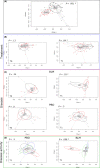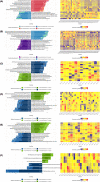Microbiota changes induced by microencapsulated sodium butyrate in patients with inflammatory bowel disease
- PMID: 32476236
- PMCID: PMC7583468
- DOI: 10.1111/nmo.13914
Microbiota changes induced by microencapsulated sodium butyrate in patients with inflammatory bowel disease
Abstract
Background: Butyrate has shown anti-inflammatory and regenerative properties, providing symptomatic relief when orally supplemented in patients suffering from various colonic diseases. We investigated the effect of a colonic-delivery formulation of butyrate on the fecal microbiota of patients with inflammatory bowel diseases (IBDs).
Methods: In this double-blind, placebo-controlled, pilot study, 49 IBD patients (n = 19 Crohn's disease, CD and n = 30 ulcerative colitis, UC) were randomized to oral administration of microencapsulated-sodium-butyrate (BLM) or placebo for 2 months, in addition to conventional therapy. Eighteen healthy volunteers (HVs) were recruited to provide a healthy microbiota model of the local people. Fecal microbiota from stool samples was assessed by 16S sequencing. Clinical disease activity and quality of life (QoL) were evaluated before and after treatment.
Key results: At baseline, HVs showed a different microbiota composition compared with IBD patients. Sodium-butyrate altered the gut microbiota of IBD patients by increasing bacteria able to produce SCFA in UC patients (Lachnospiraceae spp.) and the butyrogenic colonic bacteria in CD patients (Butyricicoccus). In UC patients, QoL was positively affected by treatment.
Conclusions and inferences: Sodium-butyrate supplementation increases the growth of bacteria able to produce SCFA with potentially anti-inflammatory action. The clinical impact of this finding requires further investigation.
Keywords: 16S metabarcoding; gut inflammation; inflammatory bowel disease; prebiotics; short-chain fatty acid.
© 2020 The Authors. Neurogastroenterology & Motility published by John Wiley & Sons Ltd.
Conflict of interest statement
The authors report no conflict of interest.
Figures





Comment in
-
Oral butyrate modulates the gut microbiota in patients with inflammatory bowel disease, most likely by reversing proinflammatory metabolic reprogramming of colonocytes.Neurogastroenterol Motil. 2021 Jan;33(1):e14038. doi: 10.1111/nmo.14038. Epub 2020 Nov 22. Neurogastroenterol Motil. 2021. PMID: 33222317 No abstract available.
-
Reply Letter to "Oral butyrate modulates the gut microbiota in patients with inflammatory bowel disease, most likely by reversing proinflammatory metabolic reprogramming of colonocytes".Neurogastroenterol Motil. 2021 Jan;33(1):e14054. doi: 10.1111/nmo.14054. Epub 2020 Dec 4. Neurogastroenterol Motil. 2021. PMID: 33274806 No abstract available.
References
-
- Sha S, Xu B, Wang X, et al. The biodiversity and composition of the dominant fecal microbiota in patients with inflammatory bowel disease. Diagn Microbiol Infect Dis. 2013;75(3):245‐251. - PubMed
-
- Laserna‐Mendieta EJ, Clooney AG, Carretero‐Gomez JF, et al. Determinants of reduced genetic capacity for butyrate synthesis by the gut microbiome in Crohn’s disease and ulcerative colitis. J Crohn’s Colitis. 2018;12(2):204‐216. - PubMed
-
- Stumpff F. A look at the smelly side of physiology: transport of short chain fatty acids. Pflugers Arch Eur J Physiol. 2018;470(4):571‐598. - PubMed
-
- den Besten G, Lange K, Havinga R, et al. Gut‐derived short‐chain fatty acids are vividly assimilated into host carbohydrates and lipids. AJP Gastrointest Liver Physiol. 2013;305(12):G900‐G910. - PubMed
-
- Nagalingam NA, Lynch SV. Role of the microbiota in inflammatory bowel diseases. Inflamm Bowel Dis. 2012;18(5):968‐980. - PubMed
Publication types
MeSH terms
Substances
LinkOut - more resources
Full Text Sources
Medical
Miscellaneous

